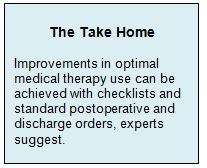Key Points:
- Retrospective analysis explores use of optimal medical therapy after carotid revascularization
- Prescription of antiplatelets, statins suboptimal at discharge
Not all eligible patients receive antiplatelet and statin therapy following discharge from US hospitals after carotid artery revascularization, new registry data show. Medical therapy use varies by the procedure type, operator specialty, hospital setting, and geographic region.
For their study, published online August 9, 2016, ahead of print in Stroke, Herbert D. Aronow, MD, of Miriam Hospital and Brown University (Providence, RI), and colleagues performed a retrospective cohort study of 23,112 patients who underwent coronary artery stenting (CAS) or carotid endarterectomy (CEA) between January 2007 and June 2012. All were treated at a US hospital participating in the CARE (Carotid Artery Revascularization and Endarterectomy) registry.
Overall, 99% of patients were prescribed antiplatelet agents and 78% were prescribed statins at discharge post-CAS. Following CEA, 93% were prescribed antiplatelets and 75% statins.
On multivariate analysis, antiplatelet therapy was found to be more often prescribed after stenting than after surgery (adjusted OR 2.4; 95% CI 1.68-3.45), but statins were equally likely to be prescribed in both groups (adjusted OR 1.11; 95% CI 0.84-1.49).
Operator specialty and hospital setting both independently predicted the likelihood of antiplatelet and statin use at discharge. Interventional cardiologists and neurologists prescribed these agents more often than did radiologists, who in turn prescribed them more often than did surgeons. Suburban hospitals prescribed the agents most often, followed by urban hospitals and then rural hospitals.
Geographic region also influenced the use of statins, which were prescribed most frequently in the Northeast, followed by hospitals in the Midwest, Southern, and Western hospitals. There was no link between region and antiplatelet use.
Mirrors What’s Seen in Cardiology
Dr. Aronow told Neurovascular Exchange that this study was inspired by the suboptimal use of medical therapy seen within the cardiovascular arena, including in patients with carotid atherosclerosis.
“It only makes sense that [we should prescribe optimal medical therapy] if we are going to subject patients to the costs and risks of these interventions,” he said. While there may have been improvements between the study period, which ended in 2012, and now, Dr. Aronow added, “I’m sure that we are not at 100% utilization, and there is still work to do and a need for novel interventions to move us toward 100% appropriate utilization.”
According to Donald Heck, MD, of Novant Health Forsyth Comprehensive Stroke Center (Winston-Salem, NC), “This is an important study to remind all of us that surgical and medical treatments are not competing, but complementary.
“The prescription of antiplatelet therapy after carotid stenting is at nearly 100%,” he told Neurovascular Exchange in an email. “Interventionists performing carotid stenting recognize the importance of antiplatelet therapy before and after stenting, and that is reflected in the data.”
But Dr. Heck added that there is room for improvement in antiplatelet use after CEA, as well as in the use of statins following both types of carotid revascularization.
Everyone on the Same Team
The study provides no direct insight into why suboptimal medical therapy is occurring, but Dr. Aronow speculated that it may relate a number of factors: communication issues between proceduralists and discharging physicians, reluctance of proceduralists to prescribe medication when they will not be following patients up themselves, different levels of comfort across specialties for using particular agents, and lack of clarity within the hospital system as to whose responsibility it is to prescribe these medications.
To this long list of possible explanations, Dr. Heck added that “there may be an education/awareness gap.”
When uncovering differences across specialties, emphasized Dr. Aronow, it is important not to “point fingers” at certain groups. “The reasons that these types of differences are observed are multifactorial and likely do not speak to particular specialties themselves but likely the workflows and care processes that might be in place to support them,” he said, adding, “We are all committed to patients and want to reduce the likelihood of future stroke to the same degree.”
The solution may be as simple as a checklist, either on paper or as an electronic reminder, Dr. Aronow noted. Similarly, Dr. Heck suggested use of standard postsurgical and discharge order sets where the default is to prescribe a statin or antiplatelet and, in cases where they are not, a reason for that decision must be given.
Source:
Aronow HD, Kennedy KF, Wayangankar SA, et al. Prescription of guideline-based medical therapies at discharge after carotid artery stenting and endarterectomy: an NCDR analysis. Stroke. 2016;Epub ahead of print.
Disclosures:
- Dr. Aronow reports receiving Patient-Centered Outcomes Research Institute funding as a coinvestigator on the PORTRAIT study
- Dr. Heck reports no relevant conflicts of interest


